Books: NUR JAHAN: WIFE TO EMPRESS

Women and minorities often don’t get the attention they deserve in history. Ruby Lal, in Empress: The Astonishing Reign of Nur Jahan (W.W. Norton), corrects that by shifting the perspective.
Legend has it that she shot a tiger, that she wooed Jahangir even as she was betrothed to another man. Time adds spice to those tales, sweetening them here, saucing them up there. Nur Jahan, the 17th century Empress of Mughal India, lived such a life. Her fascinating life and journey from immigrant to wife and empress is captured in breathtaking detail by Ruby Lal, professor of South Asian Studies at Emory University.
Nur Jahan was born outside Kandahar in modern-day Afghanistan to a couple fleeing Persia for Emperor Akbar’s India. Mihr un-Nisa, her parents named her, or “Sun of Women.” Nur’s parents, her father in particular, would rise to positions of influence in Akbar’s son Jahangir’s court. Mihr was a precocious child. At age 17, her marriage was arranged with Ali Quli, a Persian immigrant who joined the Mughal army and rose to hold a provincial government role. Different historical accounts suggest that Salim, Akbar’s son (future Emperor Jahangir) was smitten by Mihr and that he may have asked for Mihr’s hand in marriage. Lal’s account does not necessarily pick sides, but rather, uses the diverging accounts to highlight the early ties between Mihr and Salim that would eventually culminate in their marriage and in Mihr’s ascension to a position of highest influence in the Mughal Empire.
Mihr and Ali Quli had one child together, a daughter named Ladli. Having moved to Bengal for Ali’s work, Mihr became a keen observer of local customs, studying the politics of running an empire and its effects on the countryside. Around this time, Akbar died, and Salim took over as the new emperor, bestowing on himself the imperial title of Nur ad Din Jahangir or Light of Faith, Conqueror of the World.
Soon, Ali Quli was caught in the cross fires between Jahangir and his son Khusraw who plotted against Jahangir. Quli was killed by Jahangir’s emissaries, and Mihr and her daughter moved to the Emperor’s harem in Agra, where she was placed under the care of Jahangir’s mother. Lal notes that this was a significant move and demonstrated Mihr’s status in society: not as a widow of a government official but as the daughter of Ghiyas Beg, a high-ranking official in the emperor’s court.
Mihr, now Nur Jahan, Lal observes, employed her keen intellect to observe the comings and goings of daily Mughal imperial life and began to foster political alliances within the harem, donating money to the poor, and organizing the weddings and marriages of poor young girls.
Nur began supporting Jahangir in matters of state interest, dispensing advice when necessary, and supporting Khurram, Jahangir’s son and heir apparent. Nur also rehabilitated Jahangir from his rather obsessive drinking and drug habits, which observers from that time interpreted as the Queen’s naked attempts to solidify her influence over an emperor lost in his ways. Lal, however, argues that Jahangir, despite his addiction and interest in spiritual and philosophical discourse, never abdicated his duties as emperor, and traveled extensively to keep watch over his extended army and empire.
During this remarkable time in Mughal history, Nur would issue royal orders, mint coins in her name, and lead successful hunting campaigns, at a time when hunts led by emperors were a symbol of the ruler’s strength and power. As Lal argues, “born to foreign parents, she was no daughter of the dynasty, and yet no other woman in Mughal India had embodied power through official signs of sovereignty such as issuing important orders under her signature.” The book chronicles Nur’s exploits and balances contradictory historical accounts with critical analyses. Lal notes that Nur had a keen eye for design and commissioned imperial gardens and a tomb in honor of her parents, whose design would later be emulated in the Taj Mahal.
Lal’s writing is lucid, the pace of the narrative alternating between historical romance fiction and engaging nonfiction, and her tone is balanced. That the book is a feminist re-rendering of Mughal history is evident in Lal’s exploration of both European and Indian accounts of Mughal times. Where the British found Nur Jahan’s doings unbecoming of a female cohort of the emperor, other accounts found her wily, cunning, or conniving.
The book’s release in the current atmosphere of the MeToo movement comes none too soon—it’s a poignant reminder to women that the struggle for an equal voice has been real for millennia and that even if women’s leadership is condemned, inspiration can found in the unlikeliest sources.
Girija Sankar, a freelance writer and reviewer, works in global health and development in Atlanta.
Enjoyed reading Khabar magazine? Subscribe to Khabar and get a full digital copy of this Indian-American community magazine.
blog comments powered by Disqus










